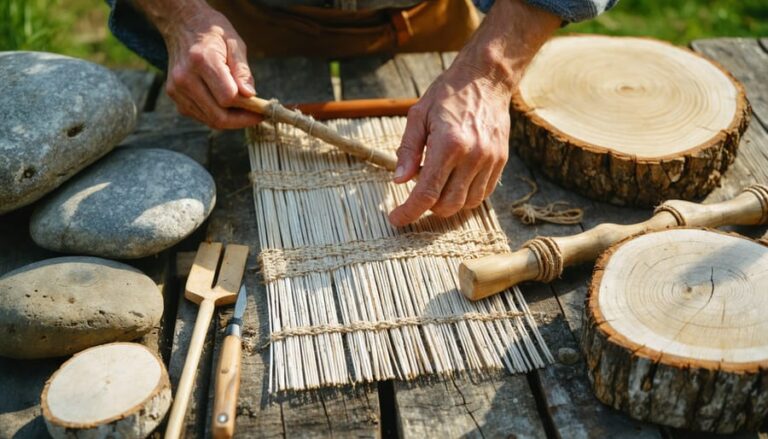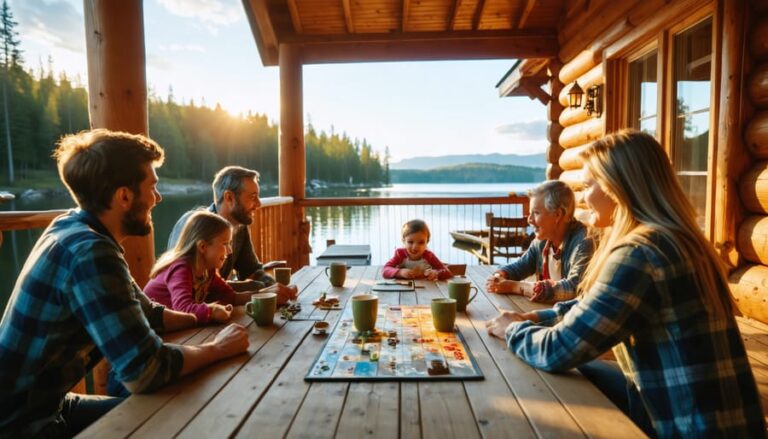Look for makers who source locally-harvested materials like birch bark, lake stones, and reclaimed barn wood when browsing artisan markets near Ontario’s provincial parks. These craftspeople reduce transportation emissions while celebrating the province’s natural beauty through every carved spoon, woven basket, and hand-thrown pottery piece.
Choose handmade goods over mass-produced souvenirs during your next outdoor adventure. A single sustainable craft purchase directly supports an artisan’s livelihood while keeping traditional skills alive—whether that’s Indigenous beadwork techniques passed down through generations or contemporary woodturning methods that transform fallen branches into functional art.
Visit studios and workshops on quieter weekdays rather than peak weekend hours. You’ll have meaningful conversations with makers about their materials, processes, and the stories behind each piece, transforming a simple purchase into an educational experience that deepens your connection to Ontario’s landscape.
Pack reusable bags specifically for artisan purchases when heading to craft fairs near hiking trails and waterfront destinations. Many sustainable makers use minimal or zero packaging, appreciating when travelers come prepared to transport delicate items safely without requesting additional wrapping materials.
The sustainable crafts movement across Ontario represents more than environmental responsibility—it’s about preserving regional identity through objects that carry genuine meaning. When you bring home a hand-forged fire poker from a blacksmith near Algonquin or a naturally-dyed scarf from a fiber artist in Prince Edward County, you’re carrying forward traditions that honor both land and legacy. These aren’t just souvenirs; they’re tangible connections to the places you’ve explored and the people who call them home.
What Makes a Craft Truly Sustainable?
The Three Pillars of Eco-Friendly Artisan Work
When you pick up a handcrafted piece from an Ontario artisan, you’re holding something that goes way beyond just looking pretty on your shelf. The best sustainable crafts rest on three essential pillars that make them truly special.
First up is environmental impact. Think about Sarah, a potter I met near Algonquin Park who digs her clay from a sustainable local source and fires her kilns using solar power. She’s not shipping materials halfway around the world or pumping harmful chemicals into our waterways. Compare that to mass-produced items, and you’ll see the difference immediately. Look for artisans who use reclaimed wood, natural dyes, or recycled materials. One woodworker in Muskoka creates stunning bowls entirely from fallen trees cleared from hiking trails.
The second pillar is community support. When you buy from local craftspeople, your money stays right here in Ontario, helping families thrive and keeping traditional skills alive. I’ve watched how craft fairs near provincial parks create ripples of economic benefit through entire small towns.
Finally, there’s longevity. A well-made basket or hand-knit sweater from an Ontario artisan can last decades, unlike cheaply made alternatives that end up in landfills within months. Jane, a fiber artist from Prince Edward County, once told me her grandmother’s hand-woven blanket is still warming beds 60 years later. That’s the kind of quality that reduces waste and creates meaningful connections between maker, buyer, and the beautiful Ontario landscape that inspires it all.
Ontario’s Natural Materials: From Forest to Finished Product
Woodworking with Reclaimed and Fallen Timber
There’s something special about woodcraft made from timber that nature itself has selected. Across Ontario, talented woodworkers are transforming storm-fallen trees and sustainably harvested wood into beautiful, functional pieces that tell the story of our forests.
In regions like Frontenac Provincial Park, where windstorms occasionally claim mature trees, artisans work with park management to salvage fallen timber that would otherwise decompose. This practice not only prevents waste but creates stunning bowls, cutting boards, and furniture with unique grain patterns shaped by decades of growth.
Here’s an insider tip: Visit local craft markets near provincial parks in late summer and fall, when woodworkers typically showcase pieces made from the previous winter’s storm harvest. You’ll often hear fascinating stories about where each piece originated—perhaps a century-old maple from a specific trail you’ve hiked.
These artisans carefully select wood that’s already been claimed by nature, ensuring no additional trees are cut for their craft. The result? Each piece carries a sense of place and purpose. When you purchase reclaimed timber woodwork, you’re supporting both sustainable forestry practices and artisans who view themselves as stewards of Ontario’s natural resources.
Look for makers who can share the provenance of their wood—the best ones love talking about their material’s journey from forest to finished product.

Natural Dyes from Ontario’s Wild Plants
Picture this: you’re hiking through Ontario’s trails in late summer, and those vibrant yellow goldenrod flowers lining the path aren’t just pretty—they’re actually a textile artist’s treasure! Local makers are rediscovering the centuries-old practice of natural dyeing using plants you’ll spot on your outdoor adventures.
Goldenrod creates stunning golden-yellow hues, while staghorn sumac berries (those fuzzy red cone-shaped clusters) produce soft peachy tones. The dark husks of black walnut trees yield rich browns that’ll remind you of autumn forest floors. Even Queen Anne’s lace, that delicate white wildflower, can create soft greens.
Here’s an insider tip: visit farmer’s markets near provincial parks to meet textile artists who’ll share their dyeing stories. Many offer workshops where you can learn to identify dye plants during guided nature walks, then create your own naturally-colored scarves or tote bags. It’s a perfect rainy-day activity after morning hikes!
Keep your eyes peeled for goldenrod along sunny trail edges from July to September. Sumac thrives at forest margins, and black walnut trees are common in southern Ontario’s mixed forests. Just remember—foraging rules vary by location, so always check regulations before collecting, and never harvest from conservation areas. Supporting local dye artists means these traditional practices stay alive while protecting Ontario’s wild spaces.

Meet the Makers: Ontario Artisans Leading the Green Craft Movement
Meet Sarah Chen at her sunlit studio just fifteen minutes from Algonquin Park’s west gate, and you’ll immediately understand why she’s become a champion of zero-waste ceramics. After years working in commercial pottery, Sarah made a radical shift five years ago. “I realized I was throwing away buckets of clay trimmings every week,” she tells me, her hands already shaping a new piece on her wheel. “Now, everything gets reclaimed and reused.” Her studio runs on solar power, and she sources clay from a quarry just 30 kilometers away. Even her glazes come from natural materials she forages during hikes through the park. You can find her distinctive earth-toned mugs and bowls at the Algonquin Outfitters store in Huntsville, where they’ve become favorites among paddlers looking for camp-worthy keepsakes. Insider tip: Visit her studio on Saturday mornings when she hosts casual drop-in sessions where visitors can watch her work and learn about sustainable pottery techniques.
Drive south to Prince Edward County and you’ll discover Marcus Thompson’s woodworking shop nestled between vineyard country and Sandbanks Provincial Park. Marcus exclusively works with salvaged wood from fallen trees and demolished barns across the region. “Every piece tells a story,” he explains, running his hand along a cutting board made from a 200-year-old beam. “This barn wood witnessed generations of farming history before becoming something new.” His commitment extends beyond materials. He uses hand tools whenever possible, powers his workshop with wind energy, and finishes pieces with locally sourced beeswax. His work appears at several craft markets along County Road 49, and you can often find him demonstrating traditional hand-planing techniques at the Wellington market on summer weekends.
These makers represent just a glimpse into Ontario’s artisan community, where environmental values meet traditional craftsmanship. Both Sarah and Marcus welcome visitors to their studios by appointment, offering a rare behind-the-scenes look at how sustainable practices shape beautiful, functional art. Planning your visit around their open studio days transforms a simple shopping trip into an authentic connection with makers who are redefining what it means to create responsibly in Ontario’s stunning natural landscape.
Traditional Indigenous Crafts and Sustainability Wisdom
Long before “sustainability” became a buzzword, Indigenous peoples across Ontario were perfecting the art of living in harmony with the land. Their approach to crafting wasn’t just about creating beautiful objects—it was a holistic practice rooted in respect, reciprocity, and deep environmental knowledge passed down through countless generations.
When you visit Indigenous artisans at cultural centers and markets throughout Ontario, you’ll witness traditional craft techniques that embody true sustainability. Basket weavers harvest black ash and sweetgrass only at specific times of year, taking just what’s needed and always giving thanks. Beadworkers create intricate designs that tell stories connecting people to the natural world. Birchbark canoe builders select trees with care, ensuring forests remain healthy for future generations.
Here’s an insider tip: Many Indigenous artists offer workshops where you can learn these time-honored practices firsthand. Imagine sitting alongside a master basket weaver, feeling the supple strips of ash in your hands while learning about the relationship between craft and conservation. These experiences transform your understanding of what sustainable really means.
The wisdom embedded in these crafts goes far beyond the physical objects. Indigenous sustainability practices teach us about patience, observation, and the importance of taking only what we need. When a quillworker spends weeks creating a single piece, using porcupine quills naturally shed in the forest, they’re demonstrating a profound alternative to our culture of mass production and disposability.
Supporting Indigenous artisans isn’t just about purchasing beautiful work—though you definitely should when you can. It’s about honoring knowledge systems that have sustained communities and ecosystems for millennia. Look for authentic pieces at Indigenous-owned galleries, powwows, and cultural festivals throughout Ontario. Many artisans also sell through their own websites and cooperatives.
By learning from and supporting these craftspeople, we’re not just preserving cultural heritage—we’re investing in a sustainable future that respects both people and planet.

Where to Find Sustainable Crafts on Your Ontario Adventure
Insider Tips for Authentic Artisan Shopping
Here’s my secret for spotting genuinely sustainable crafts: look for the story behind the piece. When I’m browsing artisan stalls near Ontario’s parks, I always ask makers about their materials. Where does that clay come from? Are those dyes plant-based? Authentic artisans light up when discussing their processes and will happily explain their sustainable practices.
Don’t be shy about asking questions. Inquire about local sourcing, whether they use reclaimed materials, or how they minimize waste. A genuine sustainable craftsperson will appreciate your interest rather than feel interrogated. I once learned that a wood carver near Frontenac Park only uses fallen trees from storm damage – that’s the kind of detail that makes a purchase meaningful.
supporting local makers goes beyond just buying their work. Ask if they offer workshops or studio visits. Many artisans welcome visitors and love sharing their craft. Take their business cards, follow them on social media, and spread the word about their work. When you invest in handmade sustainable crafts, you’re not just taking home a souvenir – you’re supporting a lifestyle that respects both creativity and our environment.
Try It Yourself: Eco-Friendly Craft Workshops and Experiences
Ready to get your hands dirty and learn time-honored techniques from Ontario’s talented artisans? There’s no better way to understand sustainable crafts than by trying them yourself, and across the province, you’ll find workshops that combine creativity with conservation in truly memorable ways.
Many provincial parks and conservation areas now offer seasonal craft workshops right on-site. Picture yourself weaving a basket from locally harvested willow branches while overlooking a pristine lake, or learning traditional pine needle basketry techniques that Indigenous peoples have practiced for generations. These outdoor sessions connect you directly with the natural materials around you, and instructors often share stories about sustainable harvesting practices that ensure these resources remain available for future craftspeople.
Scout groups and outdoor education programs have embraced these experiences too. At several Ontario parks, families can join guided sessions in nature-based crafting, from creating natural dyes using local plants to fashioning simple cordage from tree bark. Kids absolutely love these hands-on activities, and they’re learning valuable lessons about resourcefulness and environmental stewardship without even realizing it.
If you’re planning a camping trip, check ahead to see if your destination offers weekend craft intensives. Some parks host pottery workshops using locally sourced clay, while others teach woodcarving with fallen timber collected from trail maintenance. You’ll leave with a unique souvenir you made yourself and newfound skills you can practice at home.
Insider tip: Book workshops early in the season as they fill quickly, especially during summer months. Many artisans also offer private group sessions if you’re traveling with friends or organizing a special outing. Bring sunscreen, bug spray, and clothes you don’t mind getting messy. The experience of creating something beautiful with your own hands, surrounded by Ontario’s natural beauty, is truly transformative.
How Sustainable Crafts Support Ontario’s Parks and Conservation
When you purchase a handwoven basket or a carved wooden spoon from a local artisan, you’re doing more than just bringing home a beautiful souvenir. Your purchase directly supports conservation initiatives and the people who call these pristine areas home. Many craft vendors near Ontario’s provincial parks contribute portions of their sales to habitat restoration projects, trail maintenance, and wildlife protection programs. It’s a feel-good transaction that makes a real difference.
These purchases also provide vital income for rural communities near parks, helping small-scale artisans sustain their families while practicing eco-friendly crafts. Unlike mass-produced items shipped from distant factories, locally made goods have a minimal carbon footprint. You’re essentially cutting out the middleman and all those transportation emissions.
Here’s an insider tip: look for vendors who use reclaimed or locally sourced materials. I once met a woodworker at Frontenac Provincial Park who exclusively uses fallen trees cleared from hiking trails. Talk about circular economy in action!
Want to maximize your positive impact? Choose items packaged in biodegradable materials, ask artisans about their sustainability practices, and spread the word on social media when you discover exceptional eco-friendly crafters. Consider buying gifts for friends back home rather than generic souvenirs from chain stores. Every sustainable craft purchase becomes a small vote for preserving Ontario’s natural beauty for future generations of visitors and wildlife alike.
Your next Ontario adventure is calling, and now you have a meaningful way to remember it. When you’re exploring the trails, paddling the lakes, or discovering charming towns nestled in nature, keep an eye out for the talented artisans who call this province home. Each sustainable craft tells a story—of the cedar forests, the flowing rivers, and the people who’ve dedicated themselves to preserving these landscapes through their art.
Supporting local makers isn’t just about bringing home a beautiful souvenir. It’s about investing in communities that respect the land we all love to explore. That hand-thrown pottery glazed with ash from sustainable wood fires, or that woven basket made from locally harvested willow—these pieces carry the essence of Ontario’s wild spaces into your everyday life.
So on your next getaway, venture beyond the usual gift shops. Visit that studio tucked away on a country road, chat with the artist at the farmers’ market, or stop by that gallery in a heritage building. Ask about their materials, their process, their connection to the land. You’ll discover that the most memorable souvenirs aren’t just objects—they’re connections to place, to people, and to a more thoughtful way of traveling.














+ There are no comments
Add yours